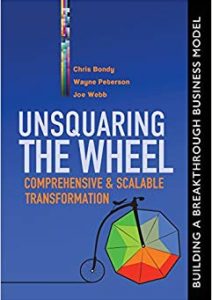It was almost in the bag…a 2-year effort. She thought she had done it all right — building key relationships, nurturing her prospect by the book. She knew their business; she knew their special needs. A strong proposal was in their hands. Her primary contact recommended a green light. No doubt, she was in the lead. And then she lost it. Why? She didn’t ask for the opportunity to make a presentation before the final decision was made. Surely, she had assumed, my excellent proposal is enough.
Your proposal is not the last step in your sales process.
So much work goes into a strong proposal — it’s a team effort. So it’s frustrating to hear that it’s not enough to count on it for a final buying decision. But there is no good substitute for a presentation to the work group before the final decision gets locked down.
A “Post-Proposal Presentation” meeting (P3) is something I coach salespeople to request for any high-value opportunity or relationship they are pursuing.
Lots of salespeople work to avoid these meetings. There are a lot of well-considered objections:
Excuse #1: “I don’t know what to say.”
If true, this is a signal that the salesperson has not figured out the customer’s motivation and selection criteria. That’s a major fail — and a topic for another time. But it could also mean that the salesperson is taking specifications too literally. It’s rare that a set of specifications or a list of buying criteria tell the whole story about how a decision will be made and how the winner will be chosen.
There is a pattern — and sequence — of how a buying decision plays out. In a significant B2B buying decision, there’s an initial screening of candidates. Next, three decisions are made from among the short list:
-
First, the decision to “buy” the salesperson,” an acknowledgement that they are a fit with the culture and personalities of the stakeholders.
-
Then, the decision to “buy” the company as in “This is a company with whom we can confidently do business.”
-
Finally, there is an acknowledgment that the product or service being offered is the “best fit” with the specific needs of the organization.
It’s only with the last decision that specifications are especially important.
Excuse #2: “I’m not good in front of groups. And I hate public speaking.”
This signals a great training/mentoring opportunity. Presentation and speaking skills are no longer “nice to have” skills for successful salespeople. They are required. Period. Excellent communication skills, confidence, and poise in front of people are a gating factor for a successful sales career.
In a commencement address at Columbia Business School Warren Buffett described taking a Dale Carnegie course in Public Speaking early in his career. The billionaire described the course as one of the best business investments he ever made. Then Buffett offered $100,000 in seed money to any of the graduates in return for 10% of future earnings. For those willing to demonstrate public speaking skills or invest in public speaking training, the offer went up to $150,000.
For salespeople, nothing is more powerful than the ability to connect effectively with an individual, small group, or larger audience. Nothing. For salespeople, communication is the killer app.
Excuse #3: “It’s already all in the proposal.”
Some mistakenly believe that the proposal itself can actually sell. Not so. Three things are wrong with that assumption. First, if that were true there would be no real role for a professional salesperson. Second, nearly all purchasing decisions are made emotionally, and very quickly — within seconds or minutes. A written proposal cannot engage emotionally that fast. Third, someone who thinks the proposal is everything is misunderstanding the true role of a proposal.
Excuse #4: “I’ve already said everything.”
This is a signal to me that the salesperson is suffering from deal fatigue. They’ve poured heart and soul into a particular opportunity for months (or years), and are not bringing fresh eyes now. At that point it is incredibly difficult to hold onto perspective. Admitting this outright is difficult, so expect to hear it expressed in other ways.
Over the past 10 years, most businesses make important buying decisions in a different way. The exploration and vetting of potential vendors often gets delegated to a technical buyer. That person may be the primary end-user, or someone who will have the most consistent interaction with the supplier. As the investigation phase moves forward, the technical buyer often provides written, summary-style updates to everyone who will be involved in the buying decision. I have seen many instances where the entire decision team met only once to discuss and consider options, and only after the proposals were in hand.
Ask anyone within a buying workgroup, and they’ll identify themselves as a decision-maker. In some cases, that may be true (because every member may have the power of veto). But, usually, only one person has the power to say the final yes. And that person, the one who could make the final commitment, may be keeping their opinions private, or withholding judgment and deferring a serious review of the potential options until the decision meeting. I have seen that behavior and that pattern play out repeatedly.
Failing to ask for the opportunity to make a final presentation is equivalent to running a marathon with no intention to put on a final sprint to the finish line.
Expecting the proposal to serve as the last step in the buying process is analogous to delegating the completion of the sales process to the technical buyer, expecting him to sell you, your company, and your offer to the decision-maker in your absence. That’s not the role of anyone on the decision-making team.
When I describe it that way it should begin to look silly to you. Even if the technical buyer is sold and believes that you, your company, and your proposal are the best, do you really want to put your fate in their hands? You have no way of knowing whether that technical buyer will be especially effective convincing and gaining agreement from the rest of the workgroup and the final decision-maker. As a salesperson, that’s your job — not his.
Asking for the opportunity to make one last presentation following the proposal just makes sense. It’s not optional. Getting over the reluctance to prepare and deliver a P3 is an essential first step. But don’t be hasty. Do it right.
Great final presentations have three things in common:
1. They are about the customer, and not about you.
I am constantly surprised by sales organizations who don’t know this. If you get nothing else right about building strong final presentations, please get this right.
One of the most powerful ways to ensure that you talk about the customer is to tell a story. Nancy Duarte has described how to use the Hero’s Journey when building a compelling presentation. It is especially powerful in this context. Newsflash: It’s the customer who’s the hero, not you. The story you tell is the journey of the customer. Begin with their challenges and pain points, describe the current state of their experience, and place yourself in a supporting role as a mentor and guide. This way you can move into a description of how they will overcome the challenges and obtain the reward — a better life that you describe as the end of your presentation. Do you homework and you will find this simple structure both easy to use and very powerful.
2. They focus on outcomes, not processes.
You may believe that you have the most elegant and exciting product or service in the world. You might be right, but don’t be surprised if it’s a yawn for the customer. What will impress them is hammering home what’s in it for them — the tangible and measurable results that they can expect. This part of your presentation has to pass the “So what?” test — especially if this is your first opportunity to be in the same room with the ultimate decision-maker. That person cares more about the destination than about the route to get there.
Your audience will happily listen to your stories, because stories are compelling. Don’t bog down the experience with a description of the intricacies of process or products. The audience cares about what you’re going to do for their team, not how you’re going to do it.
3. They make an emotional connection.
Remember, we buy emotionally. Then we back up our decision with facts. Human Nature 101. So it’s vital to demonstrate emotion (“This will be so cool for your firm!”) and also to legitimize positive emotion on the part of the customer (“I hope you’re going to feel relief and confidence almost as soon as we start.”) The range of emotion you’re trying to trigger isn’t complex, and Plutchik modeled it clearly: You’re aiming for trust, joy, and anticipation.
Any strong presentation includes emotional elements to illustrate the rewards for answering a call to action. Yes, you’ll want to use a light hand — no high drama or overwrought emoting needed. Nobody needs to cry. But you can affirm that your customer feels some measure of trust, joy, and anticipation as a direct reward for the decision. Consciously referring to the emotional and psychological rewards will help you make a stronger connection — much stronger than facts, data, comparisons and other rational factors alone.
The Post-Proposal Presentation: A Powerful Opportunity
A post-proposal presentation can be a wonderful thing both for the well-equipped salesperson and for the customer. Salespeople who skip or shy away from them (for any reason) give up a powerful opportunity to forge a strong relationship, and to distinguish themselves from their competitors who may do little more than show up and say: “You’ve got our proposal. Any questions?”
What do you think?












